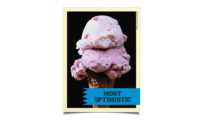A growing number of Americans seem to be convinced that some things are just better with butter. According to data from the USDA, per-capita consumption of butter reached 5.7 pounds in 2016 — up a 1.4 pounds since 1996 and a full pound since 2006.
Milk | Cheese | Cultured | Ice Cream | Butter | Non-dairy Beverages | Ingredients | Exports
Retail data back up the trend. Information Resources Inc. (IRI), a Chicago-based market research firm, reported that dollar sales for the refrigerated butter category climbed 2.3% to $2.6 billion during the 52 weeks ending Aug. 6, 2017, continuing a multi-year trend. Unit sales rose 3.4%. Moreover, four of the top-10 butter brands — Kerrygold, Cabot, Tillamook and Crystal Farms — posted double-digit dollar and unit sales increases during the same timeframe.
Butter blends also fared positively. The IRI data show that dollar sales in the segment rose 6.0% to $312.1 million, while unit sales grew 1.1% to 91.4 million.
Margarines and spreads, on the other hand, continued to trend downward. Dollar sales fell 5.1% to $1.4 billion, the IRI data show, while unit sales dropped 5.6% to 590.7 million.
Changing perceptions
Although butter got a bad rap during the low-fat and cholesterol-avoiding craze of the 1980s and 1990s, consumer perception regarding the creamy, butterfat-laden dairy product has improved dramatically in recent years. That’s due, in part, to a growing body of research suggesting that the low-fat trend was misguided. Some research even suggests that butter and other foods containing saturated fats are good for us.
“A new study of 135,000 adults published in the leading British medical journal, The Lancet, found those who cut back on fats had shorter lives than those enjoying plenty of butter, cheese and meats,” Raquel Melo, vice president of innovation business development for Land O’Lakes, St. Paul, Minnesota, pointed out.
Randy Eronimous, senior director of marketing for Seattle-based Darigold, added that butter is not the only dairy category benefiting from the demise of the low-fat trend.
“Higher dairy fat consumption is growing in all dairy categories except for cheese,” she said.
Going beyond the standard stick
The butter segment might not be as flashy as the ice cream or cheese category, but it’s beginning to show off its creative side.
“Butter continues to be on-trend, so it’s an exciting space in which to innovate,” Melo noted.
Among the more interesting products introduced in the past year are flavored butters. Epicurean Butter, Federal Heights, Colo., introduced spreadable butters under its eponymous brand in organic cocoa coconut, cinnamon & brown sugar, organic roasted garlic and five other flavor varieties. The product comes in 1-ounce single-serve pouches.
And Land O’Lakes debuted a seasonal flavor — Land O Lakes pumpkin pie spice butter spread — last year. The product was so popular, the company brought it back again this year.
“In fact, one of our biggest retail customers already sold what they thought would be the total amount they needed, so they now want twice more than the original amount,” Melo said.
Unflavored spreadable butters boast appeal, too. Parsippany, N.J.-based Finlandia Cheese Inc. recently launched a spreadable butter and a reduced-fat spreadable butter under its Finlandia brand — both contain canola oil.
For its part, Land O’Lakes added to the spreadable options under its Land O Lakes brand: less sodium butter with canola oil in a 15-ounce tub and light butter with canola oil in a larger (24-ounce) tub.
“As consumption in this category increases, we identified the need to introduce a larger size of this existing product,” Melo said of the latter product introduction, which boasts 50% less fat and 50% fewer calories than its “regular” counterpart.
And other innovations beyond flavored and spreadable butters are coming into the marketplace, noted Flavia Panza, senior director of marketing for Kansas City, Kan.-headquartered Dairy Farmers of America (DFA). These offerings, from “more regional players,” include butter compounds, hand-rolled butters and lactose-free butters.
Consumers clamor for premium, authenticity
In addition to clean label, one consumer push that will be key to category growth in next year and beyond is premiumization. Melo noted that super-premium butter — think grass-fed, organic, ethnic and ethnically influenced offerings — boasts a three-year compound annual growth rate of an impressive 33%.
And transparency also is becoming more important to consumers.
“Consumers are craving context from their food manufacturers, and brands that have an authentic narrative about doing good — ingredient sourcing, efficient and sustainable production, giving back to employees or consumers in need or green packaging — are outperforming the market,” Melo said.
For its part, DFA has been homing in on transparency and storytelling as a way to revitalize Keller’s Creamery, one of its regional butter brands. Introduced in 1906, it is the No. 2 butter brand in Philadelphia.
“Through our research, we learned that consumers in Pennsylvania did not know that the brand had roots in Montgomery, Pa., and that Keller’s butter does not have any added hormones,” Panza explained. “We are leveraging these insights and working to make sure that local consumers are more aware of this information via new packaging and a new communications campaign.”
Milk | Cheese | Cultured | Ice Cream | Butter | Non-dairy Beverages | Ingredients | Exports






